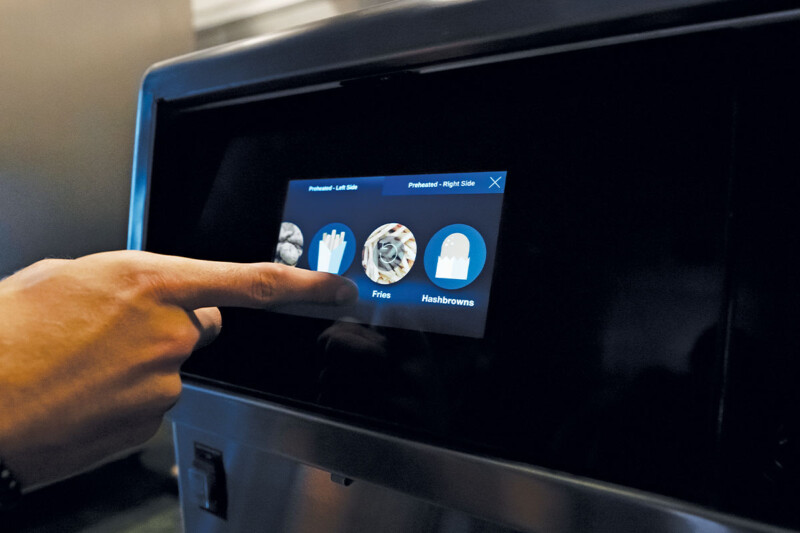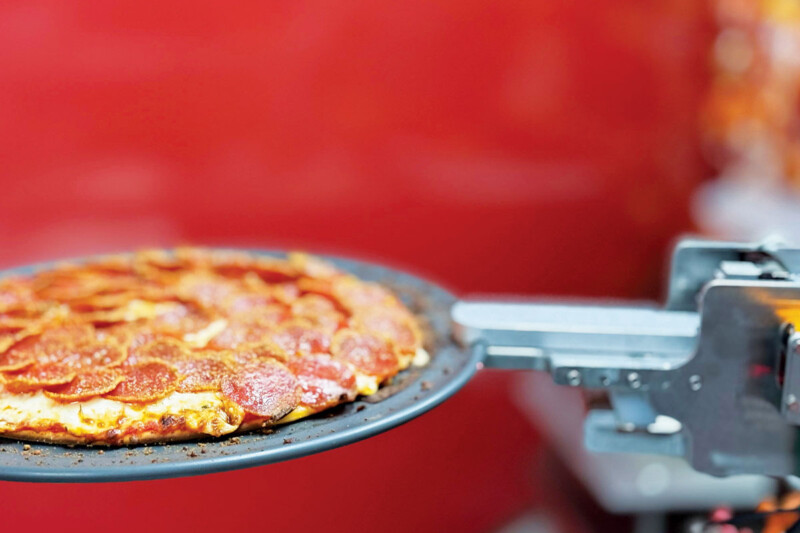Get Your Microwave Search Moving
The next generation of microwaves makes way for menu programming, among other capabilities.
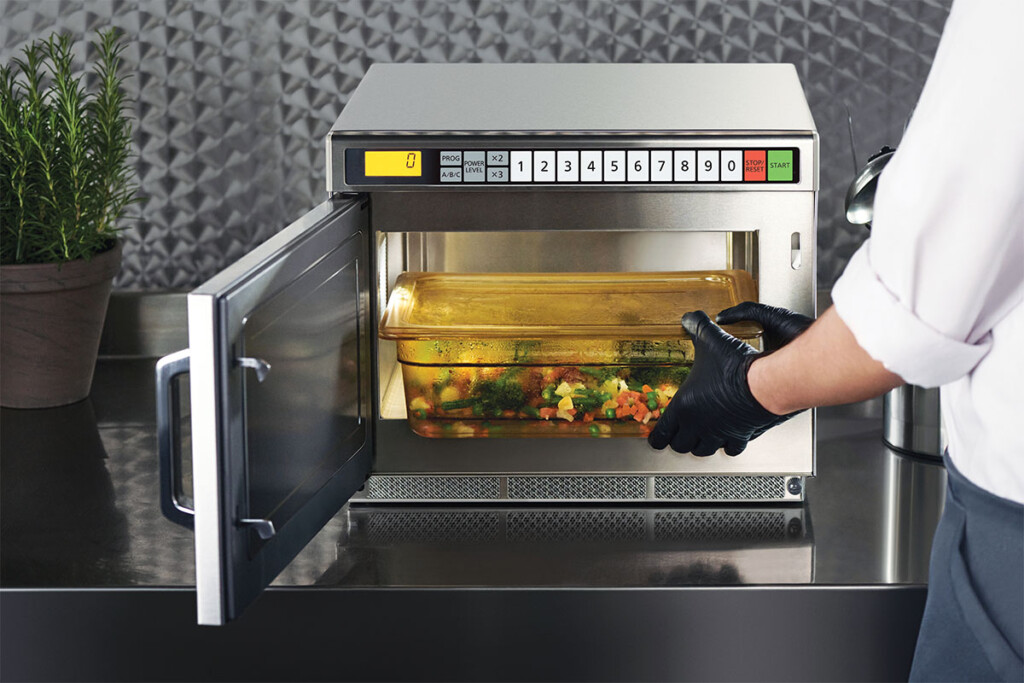
At first glance, today’s microwaves may look nearly the same as prior years’ models. It’s true that they still range from 1,000W to 3,200W in power, and their aesthetics remain similar.
But it’s what’s inside the latest microwaves that counts. The newest models step up a microwave’s cooking game by adding steam and tech-forward features that both boost convenience and add menu options.
Many operators increased their microwave use during the COVID-19 pandemic due to limited labor and off-premises cooking. The latest models turn microwaves from a temporary solution into a reliable mainstay for all kinds of kitchens.
WHAT’S IN AN OVEN?
Restaurant kitchens are rapidly growing smarter, with beverage operations in particular automating many tasks to serve more customers faster and with fewer employees. Manufacturers are pushing microwaves in the same direction. Menu programming, automatic portion adjusting buttons and automatically opening doors, for example, are a couple ways select newer microwaves can save steps.
Certain models equipped with USB ports allow kitchens to upload and seamlessly update 100-plus recipes. One USB-enabled model also includes a barcode scanner to recognize and activate hundreds of items’ specific presets.
Soon-to-launch upgrades from one manufacturer include additional sensors in the microwave that monitor food as it’s being cooked so operators can adjust recipes and cook time for greater precision. Another benefit of the latest technology: Only one or two members of your kitchen staff need to understand the technology; the rest of your team can press a button for instantly repeatable results.
Microwave heat sources also have made strides in recent years. Traditional microwaves control heat output by turning the magnetron (the oven’s power source) off and on at intervals; for example, a microwave set to 50% power shuts off its magnetron for 50% of the cook time.
Inverter microwaves, which have become increasingly popular, use a solid-state power supply; a microwave set to 50% power runs continuously at 50% power. That leads to an even cook, faster defrosting and consistent results.
While this article focuses on traditional microwaves, some manufacturers are looking beyond straightforward magnetron technology and adding steam heat sources for a microwave that does double duty. Circulating steam heat throughout the microwave retains moisture and nutrients; the same model can switch between steam and microwave heat during the same cooking cycle, so kitchens don’t have to stop and check for doneness.
“If you can steam something in a microwave quickly without it drying out and it’s consistent, that’s a pretty good recipe for success,” says one manufacturer. Preprogramming allows operators to select which heat sources each recipe requires, and for how long, to achieve a perfect result every time.
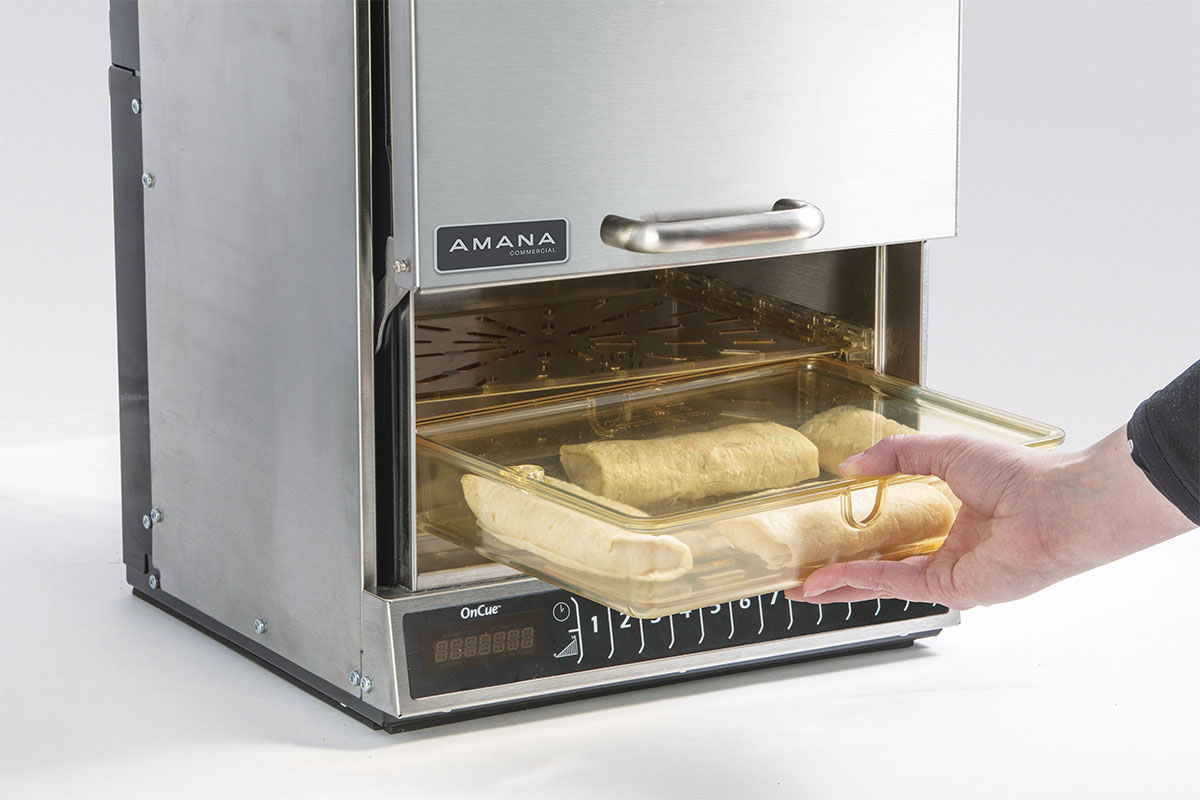
Select units ease cleaning and serviceability in different ways, including materials (like stainless interiors) and moveable or removable components. Courtesy of Amana Commercial.
MISTAKES TO AVOID
This world of new microwave capabilities means it can be tough to find a just-right fit. The decision needs to go beyond power or price to consider how you’ll use the microwave.
Manufacturers say both new customers and those looking to replace existing models are often unaware of each microwave’s ability to support a robust menu. But others may not benefit from the new breadth of heat sources; if you’re not serving large volumes of seafood, a steamer microwave might not be the right investment.
No matter how you’re using a microwave, it’s important to select the right wattage. Higher wattage equals a faster cook; one manufacturer says that if you’re considering 2,100W or higher, it makes sense to max out your menu options with a 3,200W model. These highest-watt microwaves feature more magnetrons, which means more sources of energy, less stress on the machine and better dispersion of heat throughout the cavity.
But if your kitchen uses microwaves to heat items like soup or mashed potatoes, a lower wattage is perfectly sufficient.
Remember: Commercial microwaves are not the same as your home model. On that note, don’t make the mistake of installing a noncommercial microwave anywhere in your operation, including the break room. Your insurance does not cover noncommercial models, and your claim could be denied in the case of a fire.
WORKING WITH MICROWAVES INSTEAD OF FIGHTING AGAINST THEM
While microwaves have long been a staple for delivering QSR menus, some higher-end chefs aren’t trained on their applications and breadth of opportunity. Manufacturers are stepping up to change their tune on “Chef Mike,” as the ovens are derogatorily known.
“A microwave is just a different source of energy we’re applying,” one manufacturer says. At least one manufacturer helps operations, including chains, with menu and recipe development, tuning ovens to operators’ specific needs so they gain the most value from their investment. Ask distributors or manufacturers about a brand’s demo capabilities and customer service if you’re looking for this collaborative relationship.
Manufacturers say they’re seeing increased microwave sales for food trucks, hotel kitchens and college and business campuses that rely on a satellite kitchen. Microwaves also are a future-proofing investment for those in areas exploring bans on natural gas. While this potential legislation is unlikely to affect operators anytime soon, 94% of operators of restaurants that use natural gas believe bans would negatively impact their business, according to a 2022 National Restaurant Association poll.
As kitchens increasingly shift to unique spaces that require ventless products without a water line, and update to tech-forward tools that save both time and costs, microwaves can play a larger role than ever before.
One Step at a Time
Makers outline five considerations to help guide your next microwave purchase:
1. Assess your current needs and pain points. If you’re buying your operation’s first microwave, explore flexible features like preprogrammed recipes so your microwave can grow with your restaurant. If you’re replacing outdated tools or expanding your menu, check out higher-wattage options or steam microwave models.
2. Analyze your menu and cooking requirements. If microwaves don’t factor heavily into your prep and cooking process—for example, if you’re only reheating bagged soup—a straightforward model will work just fine. Operators cooking at high volume or using their microwaves for multistage cooking should dive deeper into researching models with more bells and whistles.
3. Set a budget. Consider both your upfront cost and potential long-term savings of both time and money. High-quality models are more efficient, so you’ll cook more meals in less time. And a well-built microwave is less likely to require expensive maintenance or replacement.
4. Compare models. Pay close attention to each model’s capabilities, warranty, ease of cleaning and serviceability.
5. Speak to an expert. Don’t just rely on online research. Visit a trade show for a hands-on experience, or speak with a dealer who’s deeply familiar with the pros and cons of each model.
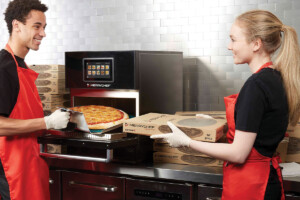
Courtesy of Merrychef
Beyond Microwaves
Also utilizing microwave power, in combination with tuned impingement and convection, is the high-speed oven—a similarly compact option with added capabilities.
The unit—able to roast, brown, crisp and more—can prep raw vegetables, pizzas and paninis, to name a few items. Select microwave manufacturers also make high-speed ovens.
For more on this product and what to consider when specifying, see FER’s January/February 2024 equipment comparison.
Take Your Time
CLOCK THE DIFFERENCES, FROM WATTAGE TO POWER LEVELS AND BEYOND ON THESE THREE MICROWAVES, ALL OF WHICH ARE STACKABLE AND HEAVY-DUTY.
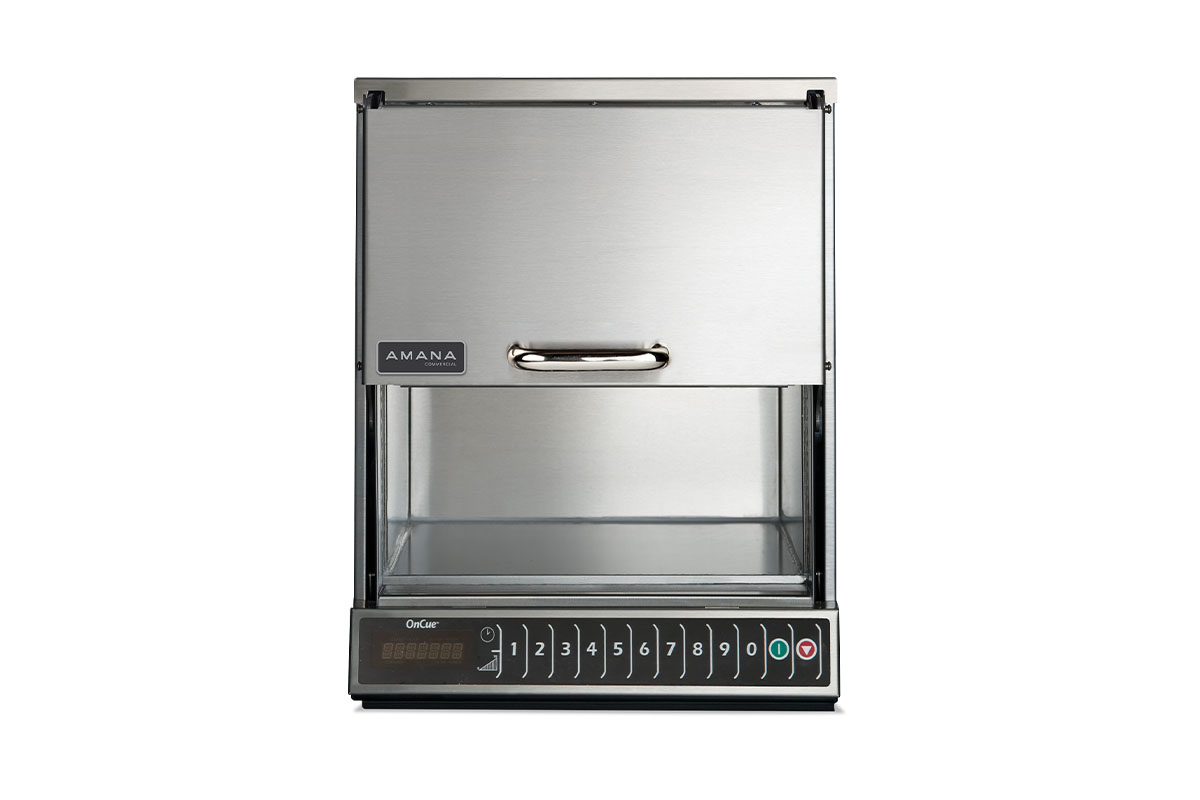
Amana Commercial
Model: AOC24
Exterior Dimensions: 13 5/8-in.W x 19 3/16-in.D x 17 5/8-in.H
Details: This 2,400W model has 11 power levels (including a defrost setting) and 10 programmable controls for up to 100 presets. Its door auto-opens at the end of a cooking cycle, then stays open, speeding throughput.
Website: acpsolutions.com
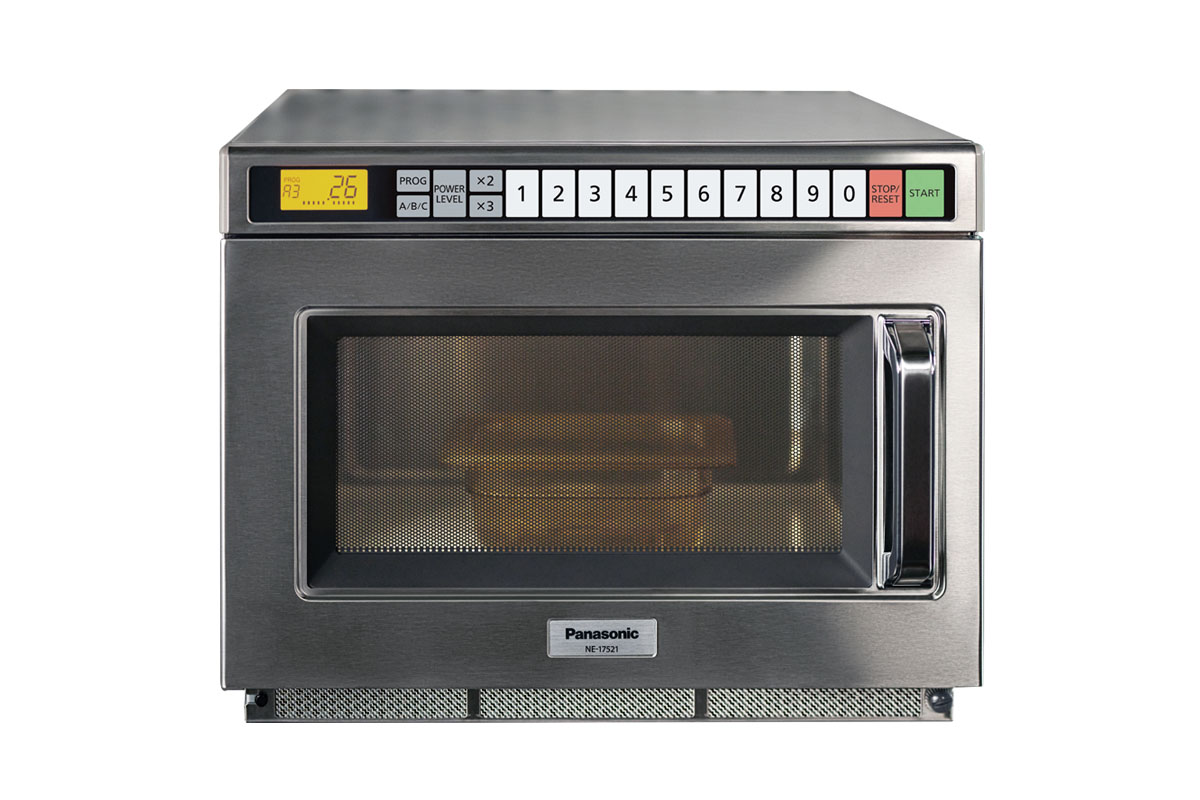
Panasonic Commercial
Model: Pro 1 Series/NE-17521
Exterior Dimensions: 16 5/8-in.W x 20-in.D x 13 1/4-in.H
Details: This 1,700W model has 15 power levels and the capacity for 30 programs across 10 keys, plus buttons that automatically adjust for up to three portions. A removable ceiling plate and rounded cooking interior ease cleaning.
Website: na.panasonic.ca/food-service/commercial
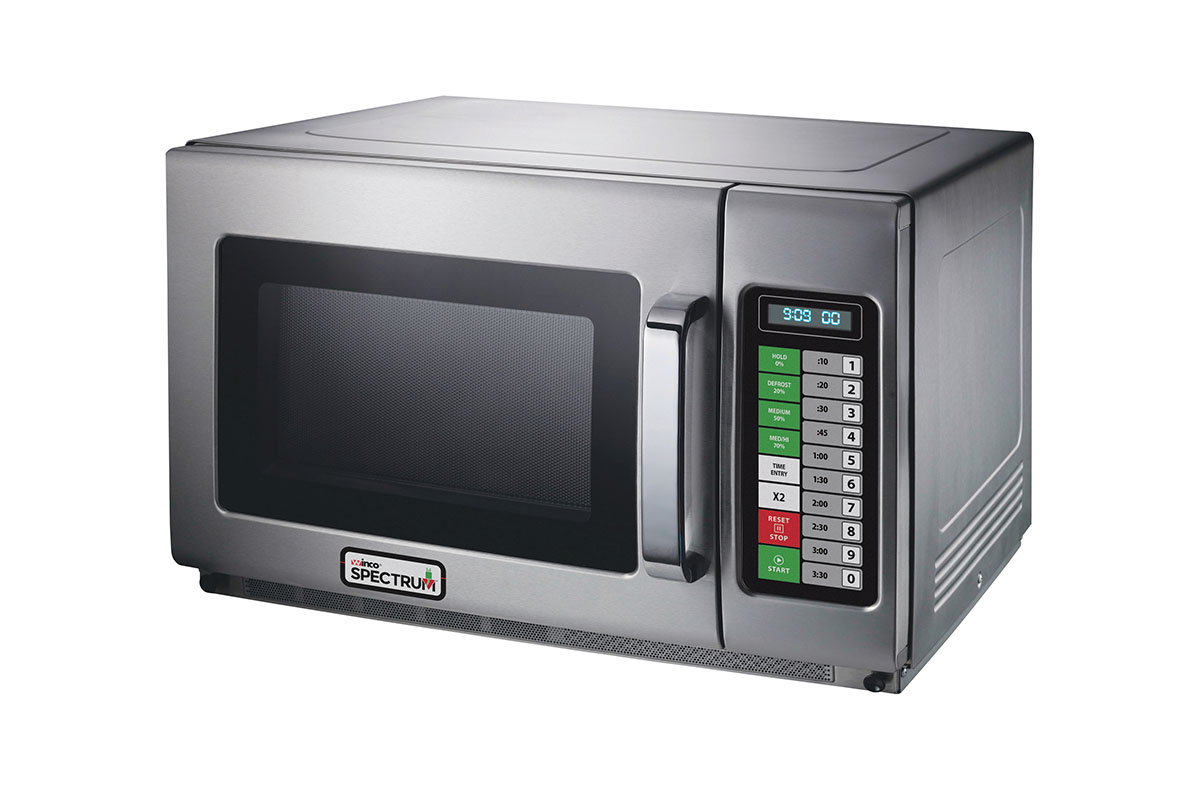
Winco
Model: EMW-2100BT
Exterior Dimensions: 22 5/8-in.W x 20 3/4-in.D x 14 1/2-in.H
Details: Tap into this model’s capacity for up to 100 cooking programs, cooking anywhere from a single portion to a 14-in. platter worth of product. The 2,100W model has five power levels. Activate cycles via 10 buttons, and consider optional accessories like a tortilla warmer.
Website: wincous.com
Editor’s note: Included models have been released or updated since December 2021.
RELATED CONTENT
- Advertisement -
- Advertisement -
- Advertisement -
TRENDING NOW
- Advertisement -
- Advertisement -
- Advertisement -

